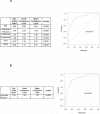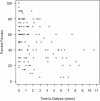Renal Interstitial Fibrosis: An Imperfect Predictor of Kidney Disease Progression in Some Patient Cohorts
- PMID: 27626625
- PMCID: PMC5069171
- DOI: 10.1159/000449511
Renal Interstitial Fibrosis: An Imperfect Predictor of Kidney Disease Progression in Some Patient Cohorts
Abstract
Background: The extent of interstitial fibrosis on kidney biopsy is regarded as a prognostic indicator and guide to treatment. Patients with extensive fibrosis are assigned to supportive treatments with the expectation that they have advanced beyond the point at which immunosuppressive or other disease-modifying therapies would be of benefit. Our study highlights some of the limitations of using interstitial fibrosis to predict who will develop end-stage renal disease (ESRD).
Methods: Analysis of 434 consecutive renal biopsies performed between 2001 and 2012 at a single center. We assessed the influence of various clinical factors along with fibrosis as predictors of ESRD and dialysis-free survival in various patient groups.
Results: Interstitial fibrosis performed well overall as a predictor of progression to dialysis. On average, patients with >50% fibrosis progressed more rapidly than those with either 25-49 or 0-24% fibrosis with a median time to dialysis of 1.2, 6.5 and >10 years, respectively. In contrast, interstitial fibrosis was of less value as a predictor of disease progression in a subset of cases that included patients over the age of 70 and those with diabetic nephropathy on biopsy. Surprisingly, 13.9% of patients with normal renal function had 25-49% fibrosis and 5% had more than 50% fibrosis on biopsy, and 5 years after undergoing biopsy 21% of patients with >50% fibrosis still remained dialysis free.
Conclusion: Renal fibrosis is an imperfect prognostic indicator for the development of ESRD and caution should be exercised in applying it too rigidly, especially in elderly or diabetic patients.
© 2016 S. Karger AG, Basel.
Figures




Comment in
-
Should We Always Defer Treatment of Kidney Disease When There Is Extensive Interstitial Fibrosis on Biopsy?Am J Nephrol. 2016;44(4):286-288. doi: 10.1159/000449513. Epub 2016 Sep 15. Am J Nephrol. 2016. PMID: 27626794 Free PMC article.
References
-
- Kostadinova-Kunovska S, Petrusevska G, Jovanovic R, Grcevska L, Bogdanovska M, Polenakovic M. Morphological changes in the tubulointerstitial compartment in primary glomerulopathies. Prilozi. 2007;28:61–74. - PubMed
-
- Madaio MP. Renal biopsy. Kidney international. 1990;38:529–543. - PubMed
-
- Seron D, Moreso F, Fulladosa X, Hueso M, Carrera M, Grinyo JM. Reliability of chronic allograft nephropathy diagnosis in sequential protocol biopsies. Kidney international. 2002;61:727–733. - PubMed
-
- Nath KA. Tubulointerstitial changes as a major determinant in the progression of renal damage. Am J Kidney Dis. 1992;20:1–17. - PubMed
Publication types
MeSH terms
Grants and funding
LinkOut - more resources
Full Text Sources
Other Literature Sources
Medical

